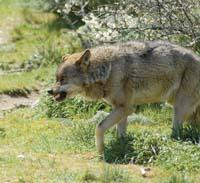Wild dogs eat more sheep than wolves in Euskal Herria
2010/02/01 Elhuyar Zientzia Iturria: Elhuyar aldizkaria

Analyzing the dissections that seemed like wolves, two researchers from the Lobo Group of Euskadi and the Doñana Biological Station of Seville have seen that European wolves feed heavily on wild prey, while sheep only feed in 3% of cases. In most cases, specifically in 70% of cases, roe deer and wild boar remains have been found in wolf feces. Sheep remains have been found in 36% of cases.
Large predators like Iberian wolves are colonizing again some areas of industrialized countries. In fact, the eastern limit of the European wolf population on the Iberian Peninsula is found in the Basque Country, mainly in Alava. In this area, the Latxa sheep are the most abundant sheep. Sheep are often unfenced and not always under the supervision of shepherds.
Many times it is reported that these sheep have been attacked, and one of the researchers of the Basque Country Otso Group, Jorge Echegaray, has said that "95% of these attacks are attributed to wolves". This has provoked conflicts between farmers, managers and agencies and groups in favor of the conservation of wolves. Wolves have a very bad reputation and suffer a great persecution, "probably unjust," says Echegaray.
For example, according to official data of the Diputación de Álava, in the period 2003-2004, 432 animals were attacked and only 10 were accused of aggression against dogs. Dogs that have become wild and uncontrolled are common and, like wolves, are able to attack animals, especially sheep. But it is rarely measured the responsibility of dogs in animal predation, among other things because it is technically difficult to determine which predator has been in a certain aggression.
Researchers have shown that genetic methods are a useful tool for solving such misunderstandings. The research collected 136 excrements that at first sight looked like European wolves. Analysis of mitochondrial DNA allowed the identification of the animal of origin of 86 excrements: 31 were of wolves, 2 of azereta and 53 of dogs.
When analyzing the remains of prey found in the excrement of wolves and dogs, it was found that each excrement had remains of a single prey. Well, in the deaths of wolves, in 27% of cases were found remains of animals, but only in 3% of cases were observed remains of sheep. In the rest, the wolves were fed on horseback and cattle. In the dog deyections, on the other hand, remains of sheep were found in 36% of cases and, in general, in 54% of the dog deyections the catches were winners.
In view of these results, Echegaray argues that the Council should question whether the number of attacks accusing wolves is "correct," which should serve to "properly design prevention and payment programs" and to reduce the conflict between natural predators and society.

Gai honi buruzko eduki gehiago
Elhuyarrek garatutako teknologia



